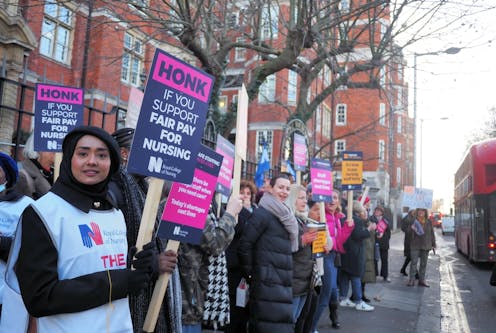why refusing public sector pay rises won't help reduce inflation
- Written by Paul Whiteley, Professor, Department of Government, University of Essex

The UK government has not yet resolved[1] the thorny issue of ongoing public sector pay disputes, despite the fact that these workers are suffering much more[2] from the cost of living crisis than their private sector counterparts. The government is worried about wage increases[3] pushing up inflation that is already sky-high[4], but recent data shows that giving these workers more pay is unlikely to have that effect.
In the year to October 2022, private sector pay increased by 6.8% compared with[5] only a 2.9% increase for the public sector. This disparity has lead to widespread industrial action in the UK[6] in recent months. On a longer-term basis, a growing pay gap is contributing to acute labour shortages, which is seriously affecting the delivery of public services such as healthcare[7] and education[8].
Voters largely support public sector workers’ current industrial disputes. When a recent poll asked the public[9] who they thought was responsible for the nurses’ strike, nearly half (49%) of respondents blamed the government and only 20% blamed the trade unions. Another poll showed 55% of the public support teachers’ current pay dispute – up from 33% recorded in a similar poll[10] ten years ago. Voters seem to see years of falling real wages for public sector workers as a problem, even if the government is not acting to raise them.
So why is the government refusing to offer a better pay deal to these workers? It argues that it is merely following the advice of the various pay review bodies[11] which make recommendations on pay in the public sector. However, these bodies are not independent of government. For example, when the government imposed a pay freeze for workers earning more than £21,000 a year in 2011 and 2012, these bodies followed this lead by making no recommendations[12] on pay for staff on higher salaries.
Fuelling inflation
Since industrial action first started to gather speed last year, concerns have been raised[13] about a wage-price spiral[14] causing entrenched inflation. This happens when rising prices prompt increased pay settlements, which in turn produce further price rises, wage increases, and so on. It happened in the UK in the 1970s[15] when, similar to now, the rate of unemployment was very low.
Indeed, the unemployment rate is key to this discussion. In the 1950s, a New Zealand economist called A.W. Phillips published research[16] showing an inverse relationship between wage inflation and unemployment in the UK that had existed for nearly a century, from 1861 to 1957. During this period when unemployment was low, wage inflation was high, and vice versa. Since then the Phillips curve[17], as it has become known, has been widely used to measure price inflation.
If this relationship still holds, it would mean that the current low unemployment level of 3.7% could trigger a wage-price spiral, particularly if public sector pay is increased. So it could be argued that the government’s refusal to raise public sector pay is a strategy to control inflation[18].
But the problem with this idea is that the Phillips curve no longer works in Britain, as the chart below shows.
Unemployment versus inflation in the UK (2001-2022)







